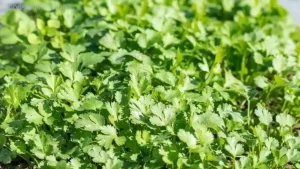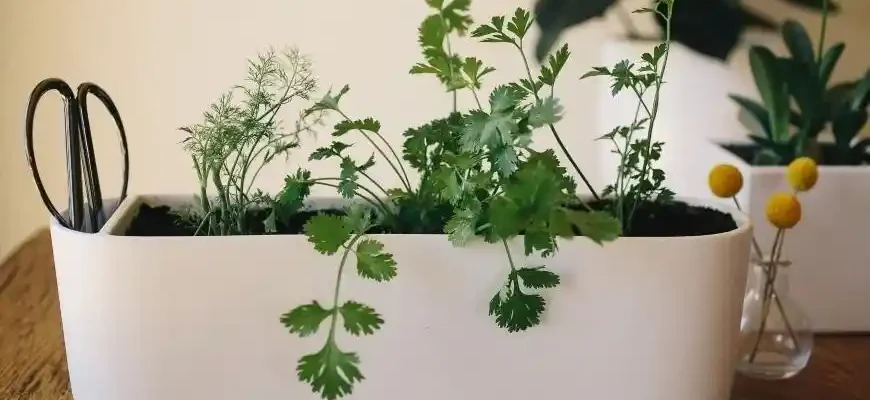If you’re looking to grow cilantro indoors, you’re in for a flavorful treat. Cilantro, also known as coriander, is a popular herb known for its distinct flavor, which adds a burst of freshness to everything from salsas to curries. The good news is that you don’t need a garden to grow it—cilantro can thrive indoors, and it’s easier than you might think. However, like all plants, it comes with its own set of needs and challenges. In this guide, we’ll cover everything you need to know about growing cilantro indoors, from seed to harvest, with practical tips, potential pitfalls, and advice on how to make it work for you.
Why Grow Cilantro Indoors?
Cilantro is a versatile herb that adds a delightful tangy taste to many dishes, especially in cuisines like Mexican, Indian, and Middle Eastern. While cilantro is typically grown outdoors in sunny garden beds, it can be successfully grown indoors as well. By growing it inside, you can have fresh cilantro at your fingertips all year long—no need to make a run to the grocery store every time you need a handful for your recipe.
Besides its culinary benefits, cilantro is packed with nutrients. It contains high amounts of vitamin K, antioxidants, and has been linked to various health benefits such as aiding digestion, reducing inflammation, and even supporting heart health. Plus, growing herbs indoors adds a touch of greenery to your home and can improve air quality, so there are a lot of good reasons to give it a try.
Getting Started: What You’ll Need
Before you start planting cilantro indoors, you’ll need a few essentials:
- Cilantro Seeds: You can buy cilantro seeds at any garden store or online. Some people also grow it from transplants, but starting from seeds is more common and cost-effective.
- Containers: Choose a pot with drainage holes (about 6-8 inches deep). Cilantro needs room for its roots to grow and doesn’t like to sit in stagnant water. Any well-draining container will work, from traditional flowerpots to repurposed containers.
- Soil: Use a lightweight, well-draining potting mix. Cilantro prefers soil that is rich in organic matter but doesn’t retain too much moisture. Avoid heavy garden soil, which can lead to root rot.
- Light: Cilantro needs at least 6 hours of sunlight per day. A south-facing windowsill is ideal, but if that’s not available, you can use grow lights. Cilantro can be a bit picky when it comes to light, so make sure it gets enough.
- Water: Cilantro likes a consistently moist but not waterlogged environment. The soil should be kept damp but not soggy. Water the plant thoroughly when the top inch of soil feels dry.
- Temperature: Cilantro thrives in moderate temperatures between 60°F and 75°F (15-24°C). It doesn’t do well with heat, so avoid placing it near radiators, stoves, or air conditioning vents.
Step-by-Step Guide to Growing Cilantro Indoors
- Planting the Seeds: Start by filling your container with soil, leaving about an inch of space at the top. Sprinkle the cilantro seeds over the surface and lightly press them into the soil (don’t bury them too deep—just a thin layer of soil on top). Water the seeds gently.
- Germination: Cilantro seeds will start to germinate in about 7-10 days, but they may take longer depending on temperature and light conditions. Keep the soil consistently moist and ensure that the container is in a warm, sunny spot.
- Caring for the Plant: Once your cilantro seedlings have sprouted, continue to provide them with plenty of light. If you’re growing cilantro indoors during winter or in low-light conditions, you may want to use a grow light. Place the grow light about 6 inches above the plants and keep it on for about 12-14 hours a day.
- Pruning: Cilantro tends to bolt (go to seed) quickly, especially when temperatures get too hot or the light conditions are not ideal. To encourage bushier growth, trim the plant regularly. You can start harvesting leaves once the plant has grown to about 6 inches tall. Be sure to pick the outer leaves first to allow the inner leaves to keep growing.
- Watering and Fertilizing: Water cilantro regularly, ensuring that the soil never dries out completely. Fertilizing isn’t absolutely necessary, but you can use a liquid fertilizer every few weeks to help the plant thrive.
- Harvesting: You can begin harvesting your cilantro when the plant has reached about 6 inches tall. Trim off the leaves with scissors, cutting above the soil level to encourage more growth. Avoid harvesting all at once—leave some leaves so the plant can continue to grow.

Common Challenges and Solutions
While cilantro is relatively easy to grow, there are a few challenges you might encounter when growing it indoors. Here’s a list of common issues and their solutions:
- Cilantro Bolting (Going to Seed): Cilantro tends to bolt quickly, especially in warm temperatures or if it’s exposed to too much sunlight. Once cilantro bolts, the flavor of the leaves changes and becomes bitter. To prevent bolting:
- Keep the plant in a cool location.
- Use grow lights to maintain a consistent light cycle.
- Harvest regularly to keep the plant producing leaves.
- Leggy Growth: If your cilantro is stretching out and not producing enough leaves, it may not be getting enough light. Move the plant to a brighter spot or use supplemental grow lights to ensure it gets enough exposure.
- Pests: Indoor plants can still attract pests like aphids, whiteflies, and spider mites. Keep an eye on your cilantro for any signs of pests, and treat them promptly with natural methods, like neem oil or insecticidal soap.
- Watering Issues: Overwatering or underwatering can both harm cilantro. Ensure your pot has drainage holes, and check the moisture level of the soil regularly. Cilantro prefers slightly moist soil, but not soggy.
- Poor Germination: If your cilantro seeds aren’t germinating well, check the freshness of your seeds, as old seeds may have reduced viability. Also, ensure the soil stays warm and moist during the germination period.
A Few Tips for Success
- Multiple Containers: To avoid a sudden shortage of cilantro, plant multiple pots at once. This way, you can stagger your harvests and always have fresh leaves on hand.
- Cilantro Variety: There are different varieties of cilantro, including slow-bolting types that are better suited for growing indoors. Look for varieties specifically bred for container or indoor growing.
- Repotting: Cilantro doesn’t like to be disturbed once it’s established, so avoid repotting unless absolutely necessary. If your plant becomes too large for its pot, it’s often better to start fresh with new seeds in a larger container.
Opinions from Real People
To give you a well-rounded view of growing cilantro indoors, here are some thoughts from people of different backgrounds and experiences:
- Maria (35, Spain): “I’ve been growing cilantro in my kitchen for years, and it’s the best thing I’ve done for my cooking! I use it in everything from stews to salads, and I love having fresh cilantro all year long. Just make sure it’s in a sunny spot, or you’ll be waiting forever for those leaves to show up.”
- John (62, USA): “I had some trouble with my cilantro not growing well indoors at first. I didn’t realize it needed so much sunlight. After I moved it closer to the window, it took off. Now I harvest fresh leaves every couple of weeks, and it’s been wonderful.”
- Yumi (50, Japan): “I grow cilantro in my apartment, and it’s a lifesaver for my meals. However, I’ve found that cilantro is very sensitive to heat. In summer, it tends to bolt quickly, so I have to keep it in a cooler room. I’ve started growing it in smaller containers, so I can rotate and have fresh cilantro constantly.”
- Luca (27, Italy): “I live in a small apartment with limited light, so I was skeptical about growing cilantro indoors. But I’m surprised—using a grow light has made all the difference. Now I’m using it in my pastas and salads, and it’s amazing.”
Growing cilantro indoors can be a satisfying and rewarding experience. By following the steps outlined above, you’ll be able to enjoy fresh, homegrown cilantro all year long. Remember that every plant has its quirks, but with a little patience and care, you can make cilantro thrive in your home. So, roll up your sleeves, grab your seeds, and get started—your taste buds will thank you!









